Cruising the Chicago River on Debris Control I
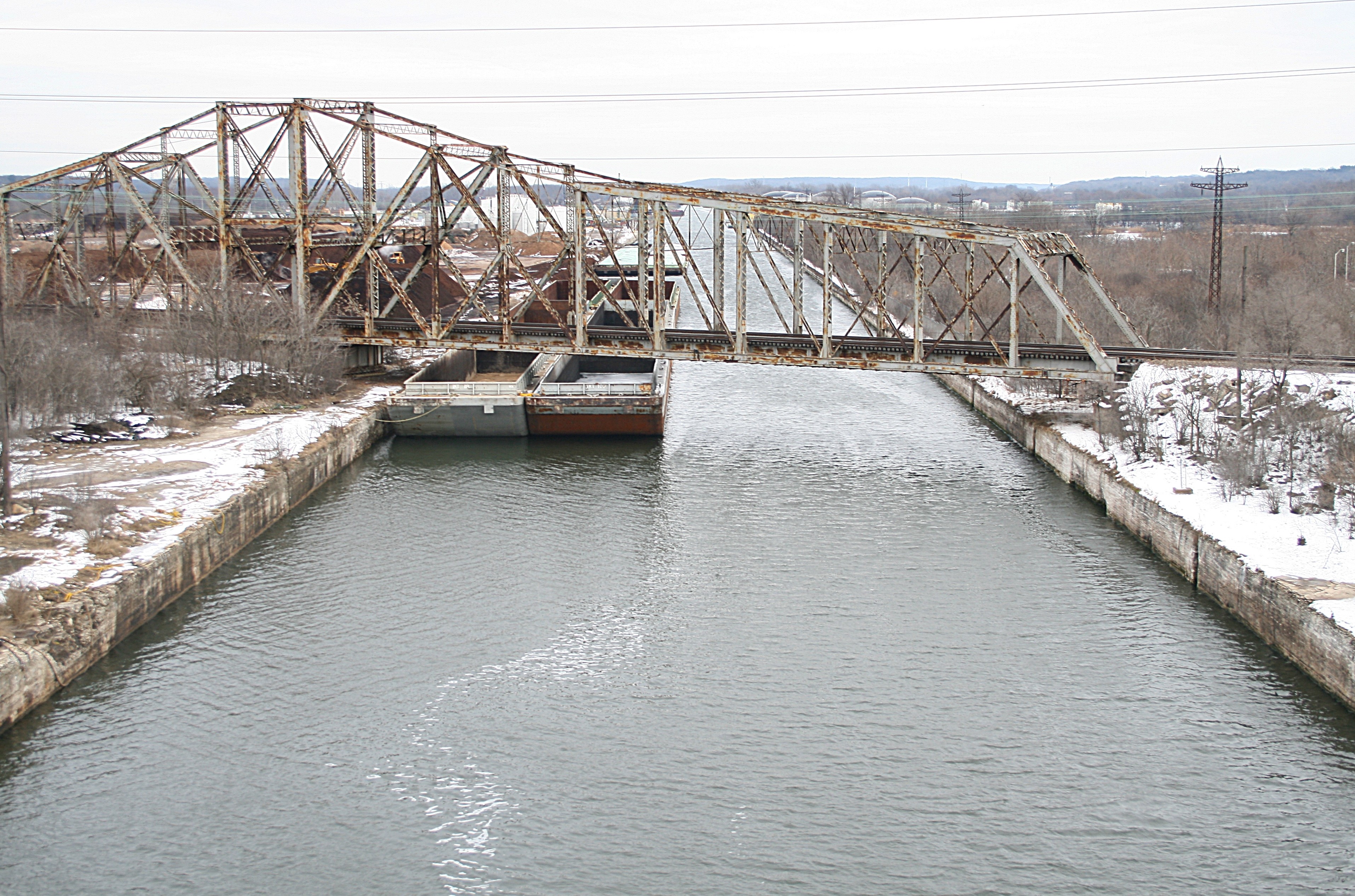 West of Chicago on the Sanitary and Ship Canal | By Muleskinner (Own work) CC 3.0, via Wikimedia Commons
West of Chicago on the Sanitary and Ship Canal | By Muleskinner (Own work) CC 3.0, via Wikimedia Commons
The air at the dock on the Chicago Sanitary & Ship Canal smells, tastes like oil.[1] The apparent cause is a grimy 37-foot towboat with a 55-foot barge hitched to the front. On the side of the boat in black letters are the words Debris Control I. A dirty American flag flies astern. On the floor of the barge is a layer of logs, tires, tangled branches, disposable everything.
Captain Ernie Vanier, who's standing in the pilothouse of the towboat, explains that the smell isn't from the boat. He points to a semicircle of floating booms against the bank. "The chemical company next door there, they had a sludge spill. First they said it was only about 700 gallons. Divers went down and said it's about a two-foot-thick layer of oil there--two feet. They've been vacuuming it up all winter."
Operated by the Metropolitan Water Reclamation District, Debris Control I pulls junk out of the waterways around Chicago--several thousand cubic yards every year. It patrols 142 miles of shoreline, from the Calumet Sag Channel to the Sanitary & Ship Canal to the branches of the Chicago River, keeping all of them navigable year-round.
At the front of the barge two Swedish hydraulic cranes droop out over the river. Eight levers in the pilothouse control the cranes--rotating them, swinging them at the elbow, extending their arms up to 28 feet, spinning the buckets. The buckets look clumsy, but they can snatch up branches that are caught between rocks as well as haul 2,000-pound limbs from beneath the water.
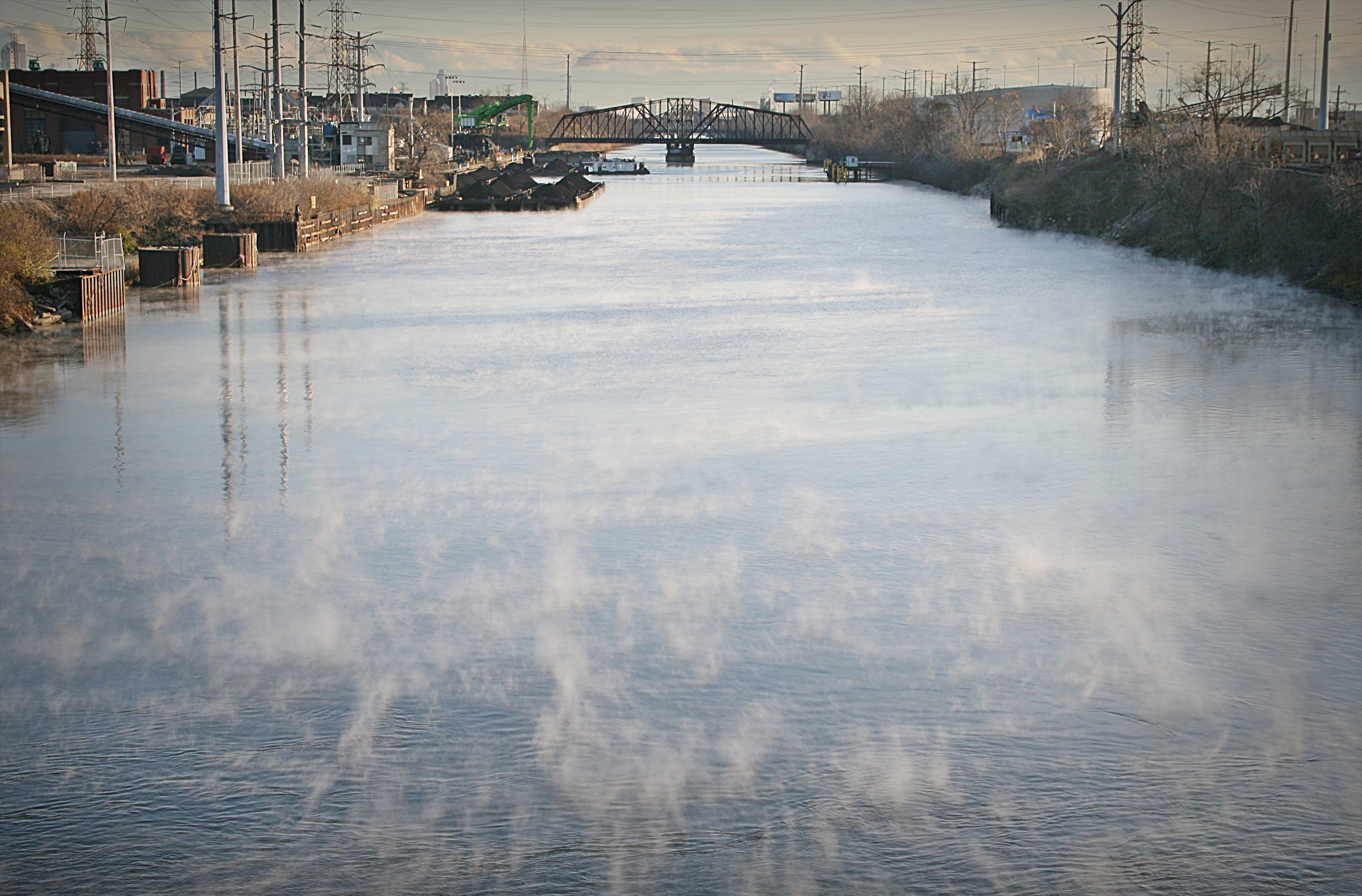 The Chicago Sanitary and Ship Canal connects the Des Plaines river eventually connecting the Mississippi to Lake Michigan [2]
The Chicago Sanitary and Ship Canal connects the Des Plaines river eventually connecting the Mississippi to Lake Michigan [2]
It's a little after 7 AM. Cool. Low light. Quiet. Vanier, who's been pulling debris out of the rivers and canals for 22 years, backs the towboat out of the dock the way you'd pull out of a parallel-parking spot, though he's steering from what would be the trunk. The towboat is like a team of Clydesdales pushing a sleigh instead of pulling it, but boat and barge move deftly across the wide canal.
Vanier props that morning's Tribune against the front window of the pilothouse and occasionally glances at it as he navigates north toward the Loop at eight knots, a little more than nine miles an hour. "A lot of this job is just traveling."
Most days Debris Control I heads up to the Loop, picking up trash on the way up and back. A priority is the junk that the public has spotted and called to complain about. As we chug past dried grasses and naked trees, rusting tanks and industrial machinery, Vanier describes what he pulls out. "The basics are man-made things. Mattresses, box springs, fenders, bags of trash, clothes, bowling balls. We've found a lot of bowling balls. You wouldn't think they'd float, but they do."
Who tosses a bowling ball in the river?
"Probably a good bowler who bowled a 98 that day." He laughs. "I don't see any golf clubs, but they are there. They just sink to the bottom."
Once Debris Control I came across a diver's suit, the old-fashioned breast-plate-and-helmet type you see in cartoons. The boat has corralled computers. It's plucked out sopping couches, bags of X-rated pictures and videos, motorcycles, bikes, car parts, and tires. Lots of tires. "It's just about everything--bar stools, tables, furniture. We get bags tied up nice, and there'll be a dead dog in it."
The 46-year-old Vanier is in charge of a three-man crew. The crane operator, who works in the pilothouse with Vanier, is Mike Eaton. The two deckhands are Ray Flores and Eric Franklin, who often stand on the rim of the barge and catch debris with a net or a long wooden staff that has a hook on the end. Once the two men found a duffel bag stuck in the mud along the shore and hooked it with the staff. The odor from it made Flores sick. It contained kittens. "It made me feel bad," says Franklin. "But what an awful smell."
"It was scary one day," Vanier says. "I saw this small thing with hair, and I thought, oh no, it's a little child! Fortunately it was just a dog. It still had hair on its head, but all the other hair had decayed off of it. Once I saw the tail my heart came out of my throat. I felt a lot better. We get way too many pets, but if you live in an apartment what do you do with it? The river. And because the river moves, people think, If I throw it in, the river takes it away. It's out of sight, out of mind for them. That's where we come in."
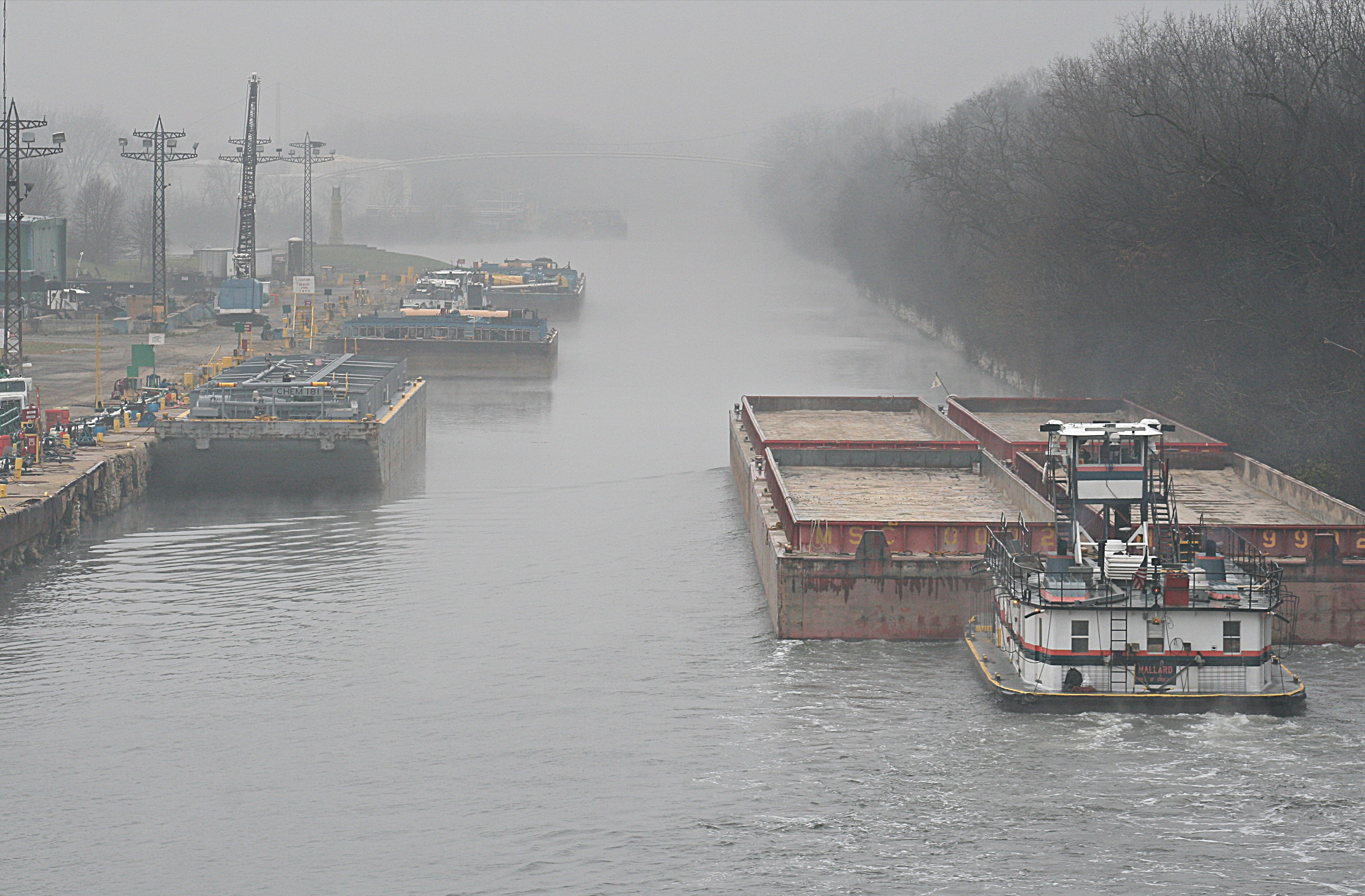 Barges dominate the canal, carrying goods in and out. Vanier's barge carries trash out.
Barges dominate the canal, carrying goods in and out. Vanier's barge carries trash out.
As we move up the canal, Vanier occasionally stops the boat to let Eaton direct the cranes at a log that's jutting above the surface, at a floating plank, at a cluster of cans and bottles trapped in a corner of the bank. The cranes hiss sharply as the hydraulic fluid pushes through their tubes at 2,800 pounds per square inch. Everything's dumped in the barge.
The crew members eye the banks, trying to guess when something will become a problem. "That tree looks close--maybe two or three weeks."
"A good rain, and this area will be a mess."
"Beaver have almost eaten that little tree away."
The debris they collect in the barge will be transferred to 30- or 60-cubic-yard steel containers once they get back to Stickney, then hauled off to landfills. "Which are further and further away," says Vanier. "And the cost is going up. When I started it cost $80 to dispose of 20 yards of debris. Now it's about $400, partly because the landfills are so far away."
"When I got this job I had never driven a boat before," says Vanier. "I was a technician working in an office downtown--your basic desk job. So one day in 1974 the boss came in and told me, "You go out on the boat tomorrow.' He had just fired the previous pilot. So my second day there was a big oil spill. I was supposed to go out there, but the crew refused. They were concerned about their safety, and I don't blame them in the least." He was supervising the people who trained him. "It took them a few weeks to gradually come around. I made a lot of mistakes when I first started. Everything I did, I was just learning. It was not a good learning experience."
He likes his job, which he says took him a decade to learn well. He says it gives him a sense of accomplishment to clean up a stretch of river. "After all these years the river is like my backyard."
Fifteen years ago the Willow Springs police were searching for a murdered woman they thought was in the trunk of a car in the Sanitary & Ship Canal. Vanier and his crew found the car and the woman. While they were searching they also discovered that the river in that area was full of cars.
Later they came back and used radar to mark all the large objects on the river bottom, then dropped a magnet on a 25-foot rope over each object. "If it stuck we marked the spot," says Vanier. "We did this all week." On Saturdays they returned with divers to check out the marked spots--nine out of ten were cars.
The divers hooked the cars to the barge, and Vanier towed them to shore, where a huge crane pulled them out of the river. In less than a dozen Saturdays they pulled out 80 cars. "At one point they were piled up five cars high in 25 feet of water," says Vanier. "All of them had been crushed by passing barges into sandwiches."
There were cars from the 50s, new cars, trucks. Vanier guesses most were dumped for the insurance money. "We pulled out a Depression-age truck. It was a frame basically. Everything had rusted away. I mean, this thing had to be down there since Al Capone and all that." He smiles. "There was air pressure in the tires too."
The rivers and canals around Chicago are cleaner than they used to be--more fish, less pollution, and less trash. "When I started in 1974, in one day we filled four 30-cubic-yard Dumpsters," says Vanier. "We couldn't make it further than one mile from the dock because we ran out of room on the barge and the river was too hard to navigate. There's probably about half the debris out there now compared to 20 years ago." He pauses. "If we weren't here you wouldn't be able to run a small boat through the river. A stump showing above the surface could be a 100-foot tree. That'd punch a hull--easy."
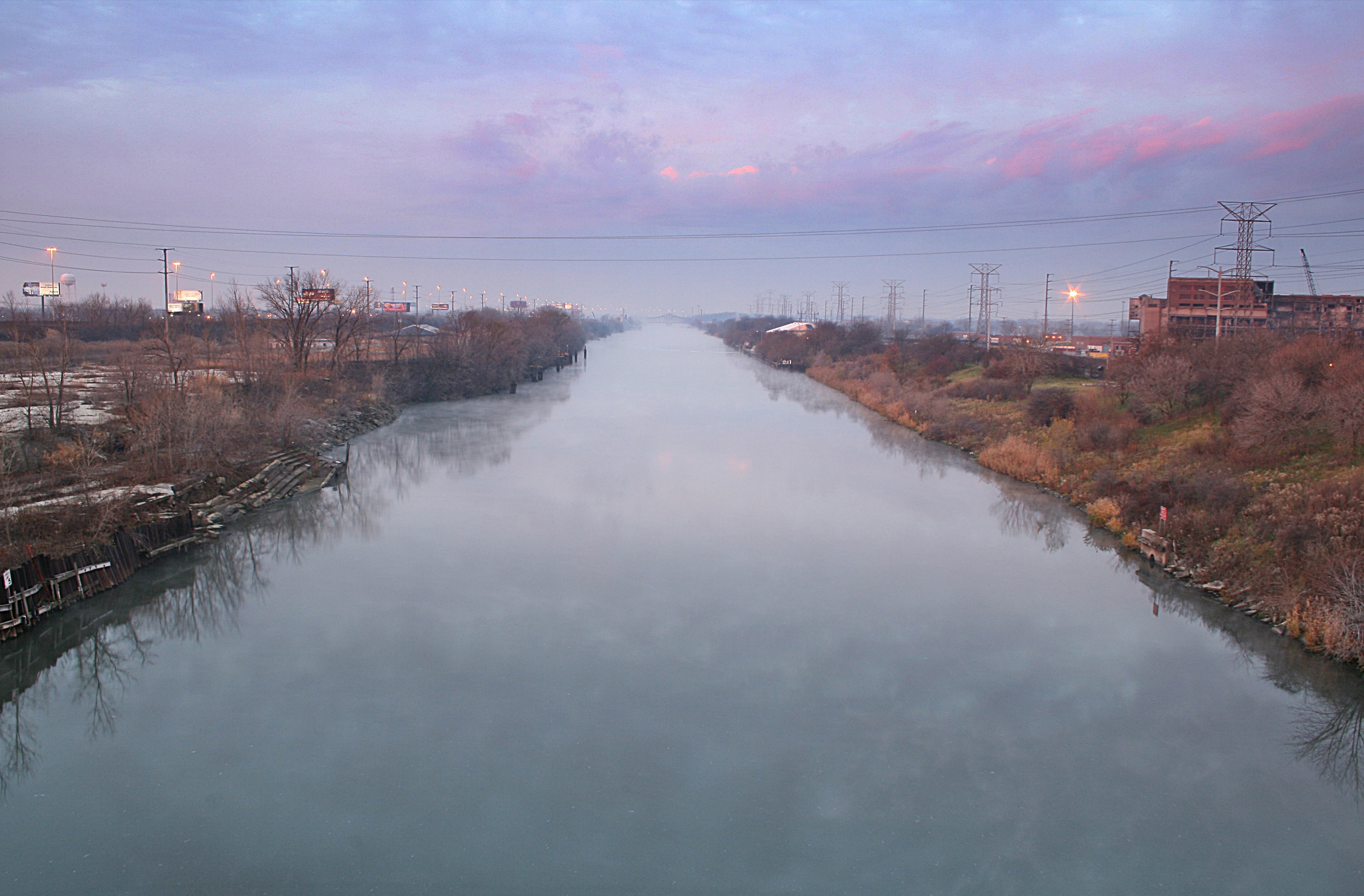 Under the surface, the team finds anything you can imagine: cars, tires, bags of counterfeit money. "We get about a body a year."
Under the surface, the team finds anything you can imagine: cars, tires, bags of counterfeit money. "We get about a body a year."
We pass the place where they found a body last week. "That opening in the bank, she probably got thrown in there," says Flores.
"Floated this way, and the wind maybe, or wake from a barge, pushed her into the corner," says Eaton.
"She wasn't a missing girl," says Flores. "She was murdered. Looked like that anyway."
"The day after Mother's Day 1994 we pulled out some guy from Oak Lawn," says Vanier. "We get about a body a year."
Last week's body, Jane Doe, got a small notice in the Sun-Times. "We always wonder, whatever happened?" says Vanier. But they rarely find out. Once they found several thousand dollars in counterfeit $100 bills. The Secret Service came and whisked them away, and the crew members never learned where they came from or what happened to them.
We pass Bubbly Creek, then a Domino packaging plant, where covered barges full of sugar that have come up the Mississippi from Louisiana are docked. We glide under a bridge where a sleeping bag and a half-full sack are snarled in shrubs. If it rains hard enough they'll wash into the river where Flores and Franklin can catch them.
"Rain is everything," says Vanier. "We had a big limb in a shallow area once. We just could not get to it, until we had a couple of big storms. The river came up, and when we got there we all pointed and screamed, "There it is!' It looked like this huge alligator floating there. "Finally!' I thought. We were trying to get that limb for a couple of years."
Eaton tries to reach a toilet and freezer that are perched on a bank. But they must have known his mechanical arm stretches only 28 feet; they're about 29 feet away. "Some good rain, and they'll wash in--and we'll get them," says Vanier, as the crane hisses and retracts.
Past a large Edison plant. Past a scrap-iron yard where huge magnets drop into mountains of metal. Past a branch that's peeking out of the water.
Eaton tries to snag the branch, but it's stuck. Vanier reverses the towboat to create a backwash, hoping that will churn the branch loose. Eaton dips the crane and grasps the branch with the bucket again, but it barely moves. We can now see it's a log that's at least ten feet long, with a diameter of about a foot. Eaton tries to find a better angle where he can get more leverage.
"The crane can lift about 800 pounds, but by moving a timber and positioning it against the side of the boat, you can swing much bigger debris onto the barge," says Vanier. "We're always pulling trees out that weigh 1,000, 2,000 pounds."
For a half hour or more the engines groan and the hydraulic tubes curse. The bucket's teeth finally chew into the log and hold, and Eaton lifts it high. It's a 60-foot tree, covered in mud.
Eaton swings the tree over the barge, gallons of river spilling out of holes in the bucket, the tree raining water. "You see that?" he says proudly, then lets it thump to the floor of the barge. Flores and Franklin move in and start cutting it up with chain saws.
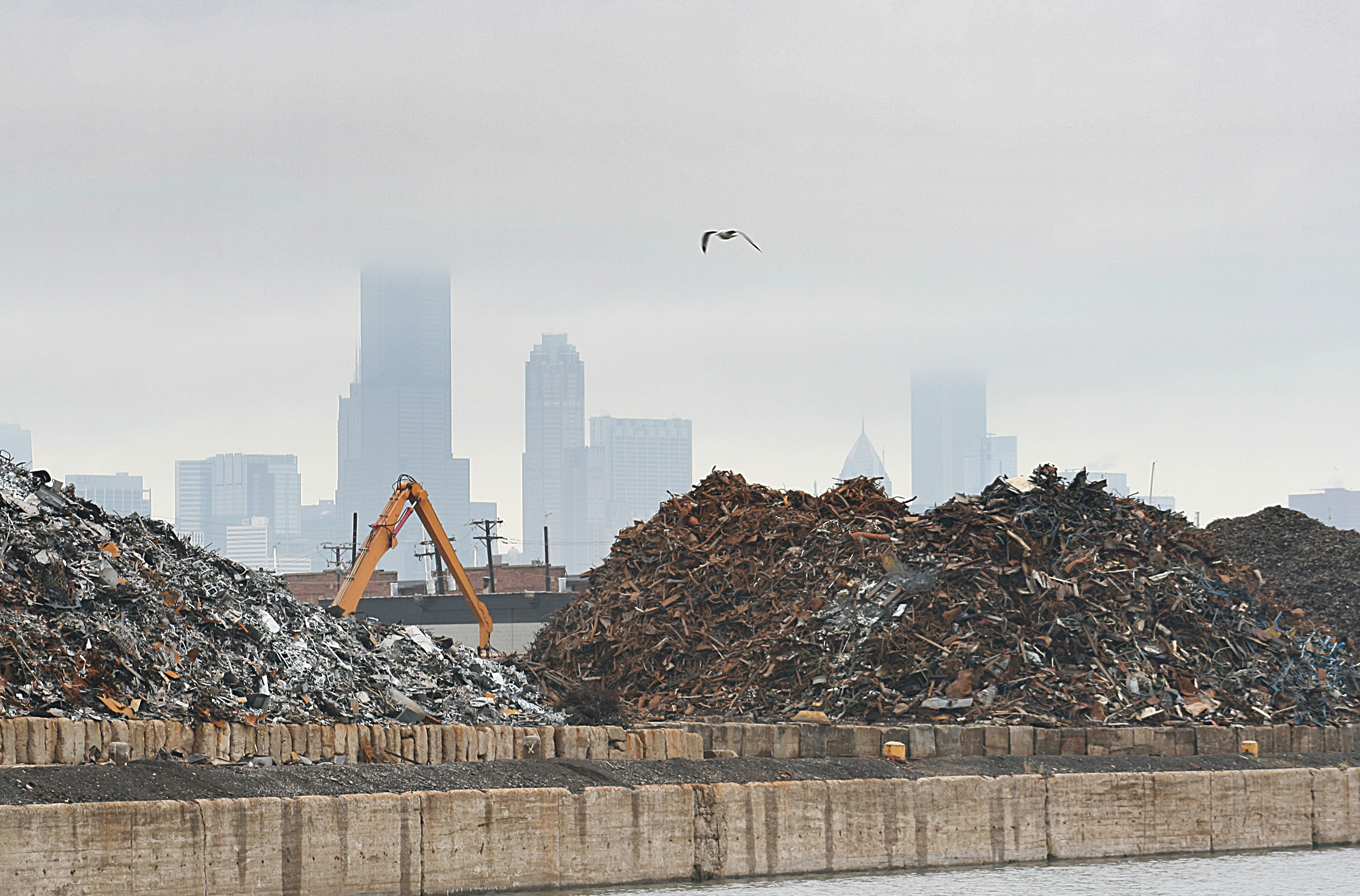 Scrap and the city.
Scrap and the city.
"Trees in the water provide a place for small fish to hide so big fish don't eat them," says Vanier. "I have trouble with my crew on this. They say, "Let's take this tree out.' But maybe that tree isn't bothering anybody--it's not going to break a boat's antenna off. It's better we go over here and drag these tires down the bank."
He shakes his head and squints. "Tires. I think a lot of people know what they're doing, and they do it anyway. Tires are a big problem to dispose of. Lots of times going down the river you find one tire, then another, then another--and you realize someone dumped a whole truckload. You end up with 30 tires on the boat. You put them in the Dumpster, and the landfill people, they get mad because tires take up space. Only two or three at a time, they tell us. Nobody wants them. Of course that's how they ended up in the river in the first place."
He doesn't have an explanation for why people dump some other things. "Every year we go to the same location, around Diversey and Damen, and every year we pull out at least a hundred shopping carts. And every year we give them back to the supermarkets. "This is a poor reflection on--I mean, why do people take a shopping cart and, instead of returning it, throw it in the river? I don't understand that. Rivers are a natural resource. Why? It baffles me."
We're heading directly toward Sears Tower. From this perspective its size seems absurd. We pass River City.
"See the pleasure boats docked here?" says Eaton. "We have to keep this area clean or those hulls will get damaged. And around here they call--we have to get right on it."
"We have to keep downtown looking nice, you know?" says Flores. "It's not like out there." He points back down the Sanitary & Ship Canal. "No one cares about out there."
"Downtown is what we do," says Vanier. Then he adds, dryly, "I think downtown is not the only part of the river."
"They complain in the Merchandise Mart area and River City," says Eaton. "Some of them call the mayor's office to tell him there's a cup in the river."
Sometimes the people call back to thank the crew. "Sometimes you're working, just doing the job, and people on a bridge will watch you and applaud or give the thumbs up," says Vanier. "That's so wonderful."
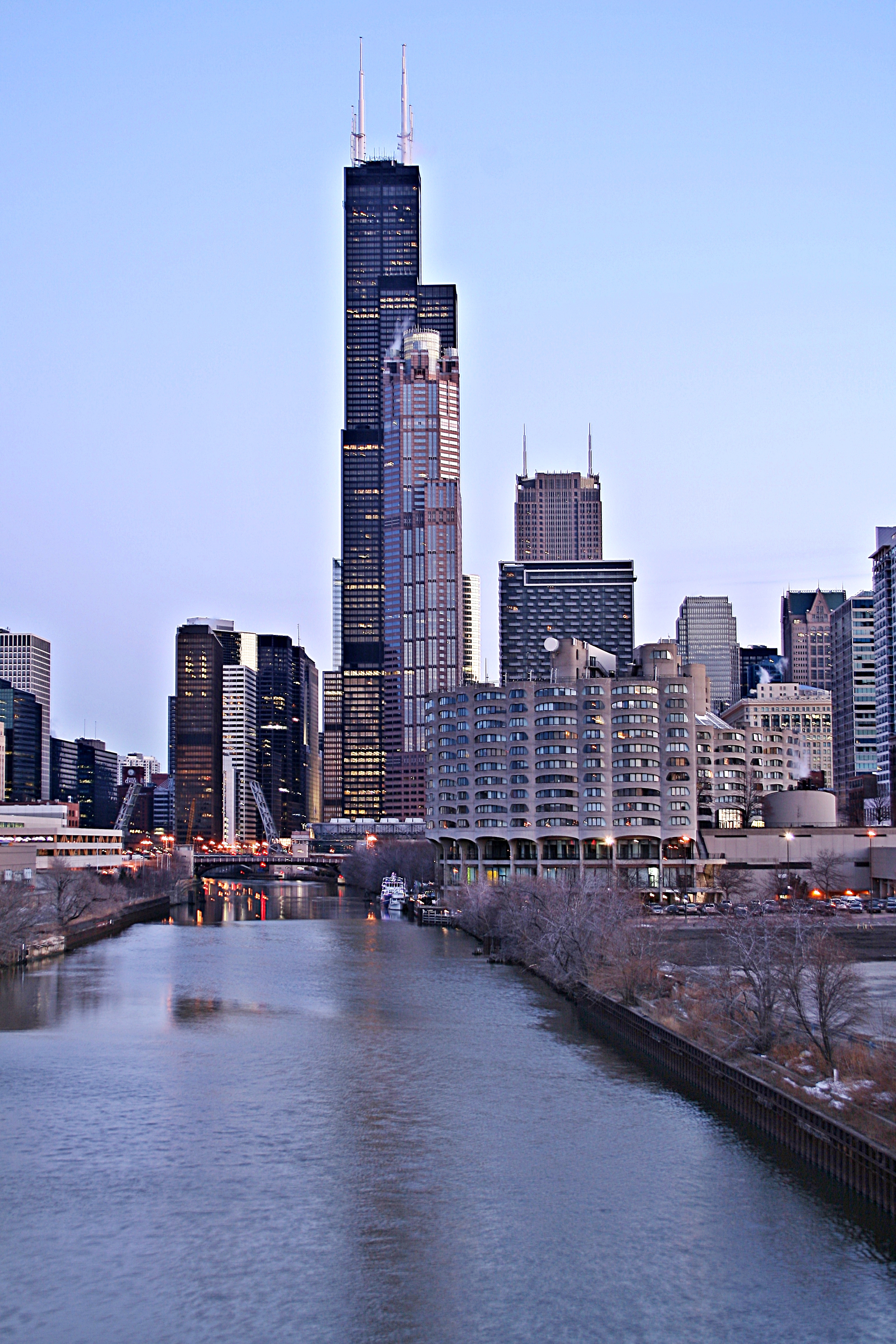 Approaching the city, where people call to complain about cups floating in the river.
Approaching the city, where people call to complain about cups floating in the river.
We move below the city. Bridges open and stop traffic so we can pass. It's cooler here. Less sun. Roosevelt. Polk. The Eisenhower. Van Buren.
Everything begins to look familiar, but only vaguely, since one never sees this side of the buildings, these angles, these light patterns. Downtown Chicago's your living room, but someone's rearranged the furniture.
"You're going to see something amazing when we get to Wolf Point," says Flores. Wolf Point is where the North Branch, the South Branch, and the Chicago River proper come together. "The water is going to change color--instantly. When we get around the bend, you won't believe it."
Under Madison. Washington. Randolph. Lake. Then it happens. A sharp line makes a wide V around the bend dividing opaque brown from translucent green. Three bright white gulls bob on the green side of the line.
Waiting for us at Wolf Point is a smaller boat that picks up smaller trash around the Loop. Skimmer, which docks along the pier east of the mouth of the river, has toothed conveyor belts that run the length of the boat. The front of the boat is hinged so that the conveyor belts can dip down into the water.
Skipper Henry Bynum, who operates the boat by himself, is all thin--thin frame, thin gray beard and mustache, thin gray hair. He's 63 and has captained the 40-foot Skimmer for three years. "We have exacting customers down here, so I have to get all the stuff that drains or blows into the river. I've picked up empty suitcases, full suitcases, empty briefcases, full briefcases, bottles, cups, paper, planks. Lots of twigs and branches. Sometimes the branches and planks are too long for this boat."
On the deck, in a mesh of branches and twigs, are a Copenhagen tin, a rubber ball, a baseball, a red plastic fuel container, a bicycle helmet, a cup labeled Bacchus above a picture of the Greek god and the year 1993.
Bynum dips the mouth of his craft into the water and moves through the debris floating in the middle of the river just east of Wolf Point. He catches a Hardee's cup. "I once found kittens in a plastic garbage bag," he says. "They were still living, so I let them go on the bank." Sometimes children see him working and throw things into the water just to see the metal jowls scoop them up.
On the bank of Goose Island are a lawn chair and part of a windshield. Just offshore is a half-submerged wreck. You can still see its name, Showboat Sari-S II. A condom floats nearby. Skimmer scoops up the condom.
His boat piled high with junk, Bynum backs up next to Debris Control I and reverses the conveyor belts. A tire, part of a couch, the Hardee's cup--all tumble into the barge, where Franklin and Flores rake it level. They've set aside some Rolodexes on a picnic table that they use as a workbench. "A few months ago we found a bag of women's golf shoes," says Flores. "A hundred pairs--brand-new."
Skimmer heads east to refuel, and we turn and start back toward Stickney. It's early afternoon, and the barge is nearly full. We pass back under the bridges and out into the open again.
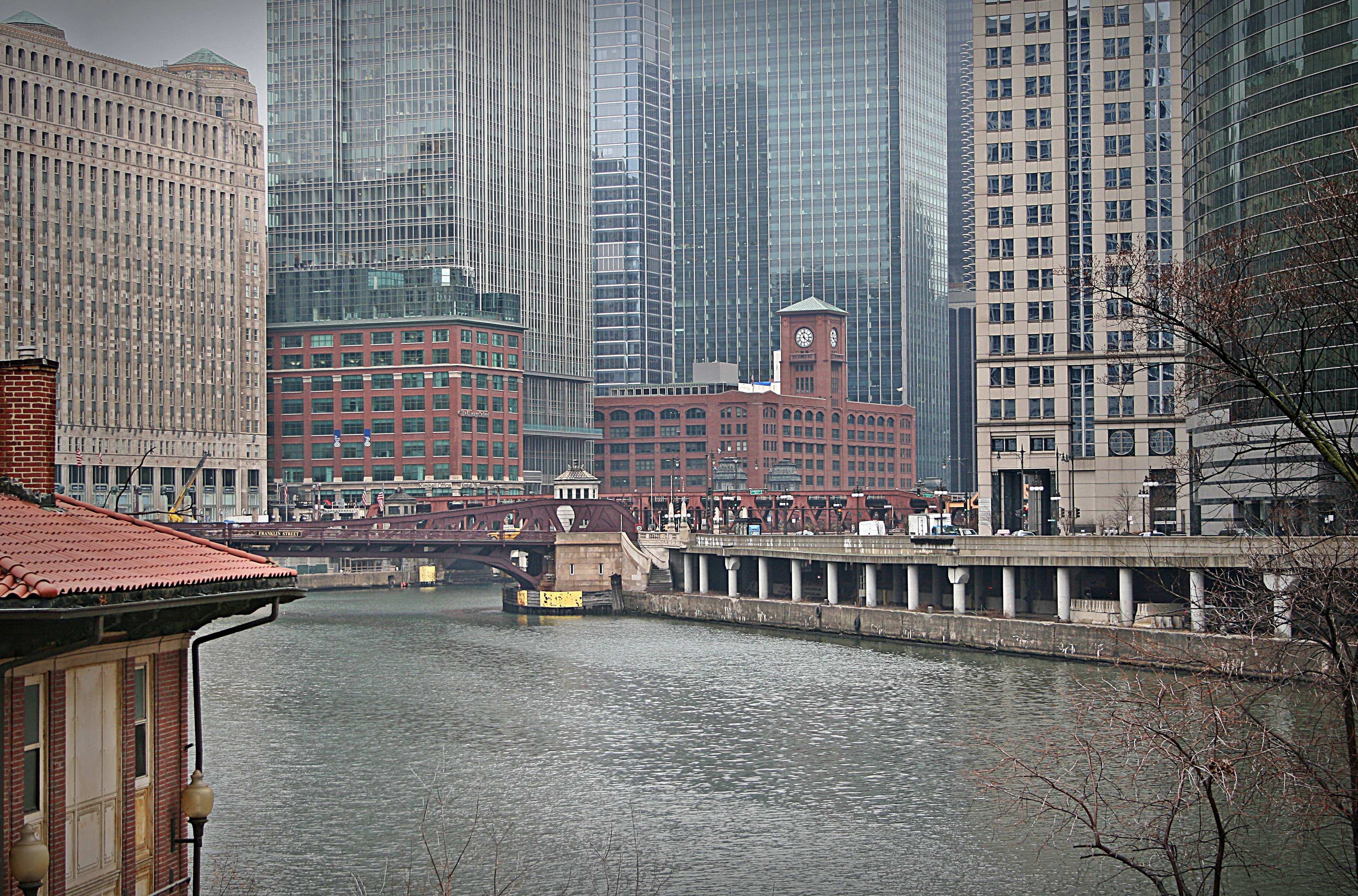 Downtown in the Chicago River proper, a smaller boat, Skimmer, nimbly scoots around collecting the trash that catches the wind and lands in the river."
Downtown in the Chicago River proper, a smaller boat, Skimmer, nimbly scoots around collecting the trash that catches the wind and lands in the river."
Just north of River City we stop to let Eaton pull a door from the water that still has a knob on it. The bucket on the crane crunches the wood like dead leaves.
"There's beaver down here," says Vanier, pointing to several gnawed stumps along the bank south of River City. "It's hard to believe you can see a beaver this close to downtown. There are beavers, pheasants, great horned owls, red-tailed hawks, buzzards, vultures, deer--a lot of deer. There's a lot more deer now than when I started, and there was no beaver when I started. There wasn't any coyote when I started. I see beaver and coyote all the time now." And more fish, especially game fish.
Near Bubbly Creak Eaton tries to wrestle a mattress and box spring into the barge. Vanier reverses the engines to get a better position along the bank. Inky black acrid water gurgles alongside the boat. "That is major pollution down there," says Vanier. He says raw sewage often still runs into the river here. "It sucks all the oxygen out of the water. After a big rain we always find dead fish. The Deep Tunnel system is the solution though, and when it's finished hopefully even more fish will return."[3]
Vanier's alone in the pilothouse. Asked if he feels a little like an unsung hero, he smiles wryly and shakes his head no. He stares at the river awhile, then says, "They're eliminating my position. They're cost cutting, but they're not eliminating the boat. They're going to eliminate me--with 22 years' experience, with above-average service ratings for 22 years, with a professional pilot's license." He isn't sure who'll replace him; he says he's the Water District's only pilot licensed by the Coast Guard. And he points out that union rules would force the District to pay any replacement, even if he has no experience, the same salary Vanier makes. "I don't understand what they'd gain. If they shut the boat down, that would make sense for cost cutting. But then I'd ask, why are you making the river dirtier?
"The only thing that makes me mad is the safety factor. If they're going to put someone out there with no experience and an accident happens--that could have been avoided. But I don't want to be mad about it. I am thankful for 22 years on the river."
He's quiet for a while, then says, "I've had a lot of personal satisfaction cleaning the river. I take a lot of pride in making sure it's clean. But I think I will file a grievance when it happens." Later a spokesperson for the Water District says, "He has a safe job with the District. If at some point in the future budget concerns make it necessary for him to do a different job than pilot the boat, we very well might do that."
Back at the dock the air still stinks. Vanier docks Debris Control I, and Eaton starts grabbing big clumps of trash from the barge and letting them fall into a huge steel container beside the dock. There goes the door with the doorknob. There goes the mattress and box spring and the Rolodexes. The pieces of the 60-foot tree are snatched up and spit out.
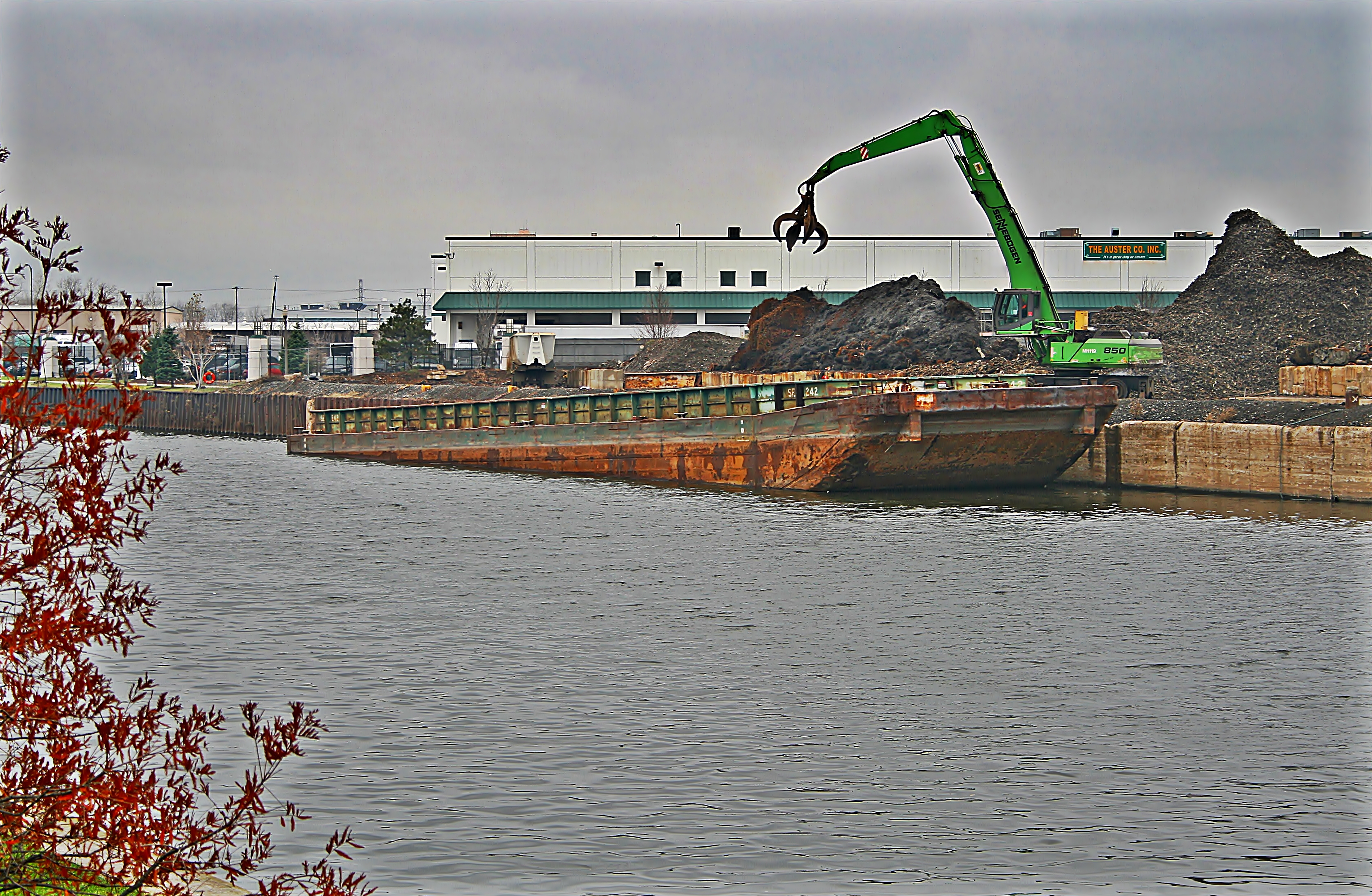
I wrote this for the Chicago Reader and submitted it with the title "The Last Five Things they Pulled Out of the Chicago River" and the lede was a bullet list of those five things plus the sentence: "Last week, they dragged up a body." However dramatic and contrived, I'm still fond of that construction, but editors there, who knew far better than some 25-year old punk, ditched it for the current form. ↩︎
The images in this story are from an incredible series of photos by Joe Balynas, who graciously gave me permission to reuse them. See the whole series, and more of his work, here. ↩︎
Going back to this story I looked up what had happened to the CSSC, and Vanier was right: the fish returned. Only some of the fish that returned wer invasive Asian carp. It appears, parts of the canal now use electrified barriers to keep the carp and other invasive species from overtaking the waterway. ↩︎